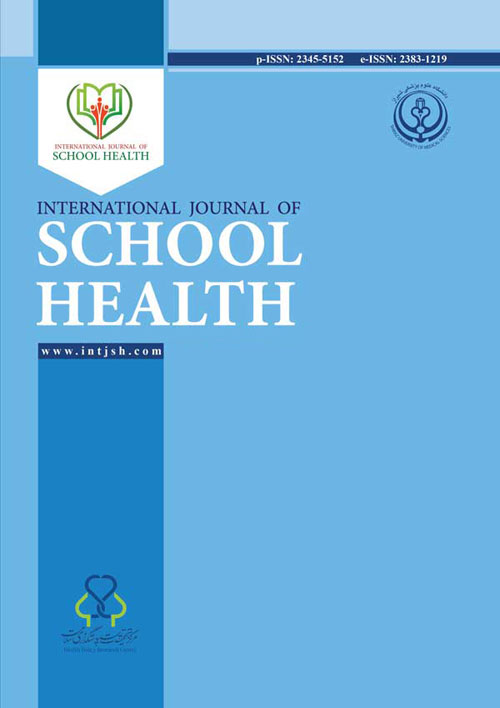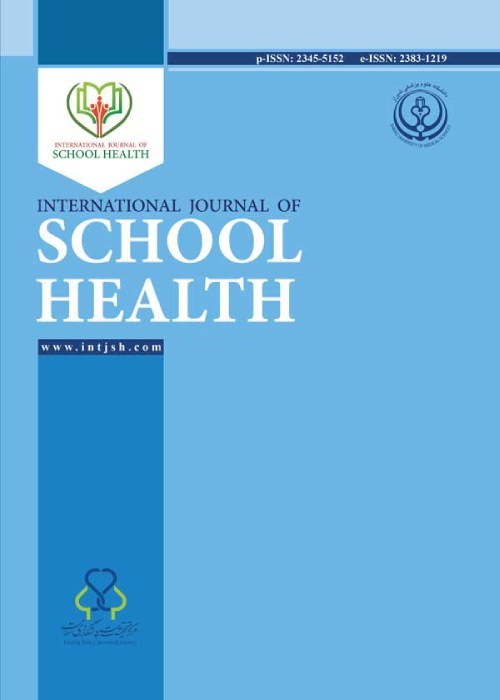فهرست مطالب

International Journal of School Health
Volume:6 Issue: 4, Autumn 2019
- تاریخ انتشار: 1398/07/09
- تعداد عناوین: 6
-
-
Pages 1-6BackgroundLordosis is a curvature in the posterior of vertebral column. Loss of normal lordotic alignment may induce pathologic changes in the spine from load bearing and accelerate degeneration of the functional motion units. The purpose of this study was to compare the effect of the corrective exercises of the National Academy of Sports Medicine (NASM) and Pilates on the correction of lumbar lordosis among female high school students.MethodsIn this experimental study, conducted in 2018, 45 female high school students suffering from lumbar lordosis were randomly selected from Golestan Province and divided into three groups of NASM corrective exercises, Pilates exercises and control. The two intervention groups received corrective exercises for eight weeks, the angle of lordosis was measured prior to and following the intervention, and the analysis of variance was used at a significant level of P<0.05.ResultsThe results showed that both 8-week corrective NASM (P=0.03) and 8-week Pilates exercises (P=0.01) had a significant effect on the angle of lumbar lordosis. However, no significant differences were observed in the control group in this regard (P=0.7). Moreover, according to ANOVA test, there were no significant differences among the three groups regarding lordosis angle prior to the intervention (P=0.13 and F=2.14).ConclusionBased on the results of the present study, the lumbar lordosis angle decreased in both NASM and Pilates exercises groups following the intervention, with NASM exercises resulting in more reduction in the lumbar curvature compared with Pilates exercises. Therefore, therapists and experts of corrective movements can make use of these exercises as novel approachesto correcting lordosis.Keywords: Lumbar lordosis, Corrective exercises of the National Academy of Sports Medicine (NASM), Pilates exercises
-
Pages 7-13BackgroundMany African children with Attention Deficit Hyperactivity Disorder (ADHD) do not receive adequate treatment services despite the availability of effective treatments. Studies have majorly concentrated on assessing the contribution of knowledge deficit among parents while neglecting teachers who play a significant role in their upbringing. The present study hoped to address this by exploring the beliefs and misconceptions about ADHD and their effect on treatment acceptability in primary school teachers in Botswana.MethodsThis was a cross-sectional study conducted among 264 primary school teachers, using a modified ADHD Beliefs Scale. Data was obtained using a two-stage random sampling technique.ResultsThe mean age of the participant was 39 (9.3) years and they were mostly females (72.7%). One hundred and ten (41.7%) of the schoolteachers do not believe in orthodox treatments. Those with professional development (OR=0.56, 95%CI: 0.32-0.97) and interest in teaching children with ADHD (OR=0.31, 95%CI: 0.19-0.54) were less likely to refuse orthodox treatment, while those with high myth score were more likely to refuse orthodox treatment (OR=1.08, 95%CI: 1.01-1.16).ConclusionThe existence of erroneous conceptions about ADHD and the rejection of orthodox treatment among a sample of teachers in Botswana is notable. Whilst misconception was shown to discourage orthodox treatment acceptability, personal interest in knowledge, and appropriate training were shown to increase its acceptability. It is; therefore, possible that with adequate informative training to correct the myth surrounding ADHD, there would be an improved acceptance of orthodox treatment.Keywords: ADHD, Botswana, Myth, Orthodox treatment, Primary school teacher
-
Pages 14-20BackgroundSince death anxiety is a potential risk for adolescent suicide, it is important to identify the related factors for promoting positive life attitudes and suicide prevention in high school students in Macao. For this aim, we assessed the level of death anxiety of the adolescents with Chinese ethnicity and explored its socio-demographic correlations.MethodsA cross-sectional survey was conducted on 2,687 adolescents aged 14 years or above, recruited from ten high schools in Macao during June 2015. A self-administrated questionnaire was distributed to the participants and was completed autonomously and anonymously.ResultsOur findings indicated the average death anxiety score of high school adolescents in Macao was within the general norm of 4.5 to 7.0 (6.97, SD=3.13). Female adolescents (t=-7.914, P<0.001) who studied in senior secondary school (t=-3.952, P<0.001) had participated in life and death education (t=-2.275, P=0.023) with religious belief (t=-2.451, P=0.014) and attended school with religious background (t=-3.42, P=0.001) reported significant differences in death anxiety. Furthermore, weak mediating effect of religious belief (OR=0.04, P=0.042) and school attendance with religious background (OR=0.06, P=0.004) were found to be effective in reducing death anxiety in these adolescents.ConclusionThis is the first study to examine death anxiety of Chinese adolescents. Our findings suggest the need to pay attention on the effect of religious belief and cultural considerations for designing life and death education in Chinese adolescents.Keywords: Death anxiety, Adolescents, Chinese
-
Pages 21-26BackgroundDue to the formation of identity in adolescence and the importance of this subject in this period and also many factors playing an important role in this field, this study aims to identify ways to enhance identification in high school students.MethodsThis is a qualitative study conducted by Delphi method. Twenty-five psychologists and sociologists in the field of education were selected to participate in the study. Experts received 5 full-fledged questions about the ways to enhance identity in high school students. After receiving the forms, experts’ opinions were categorized and semi-structured, then, in a four-step Delphi, a consensus was reached among the experts in this field. The Kendall Coordinating Coefficient was used to examine the agreement between the experts and Friedman’s test to rank each of the enhancements of adolescents’ identification factors.ResultsFindings showed that among the proposed methods by the experts, 13 factors were agreed upon by the experts. The highest rank is to increase self-esteem and the lowest rank is preserving cultural values.ConclusionAccording to the results, holding educational courses for parents and students, equipping and enriching schools, and taking into account extracurricular activities to facilitate easy identification of the students is recommended.Keywords: Identity, Identification, Student, School
-
Pages 27-33BackgroundPhysical activity stimulates the growth rate and reduces the risk factors of human health. The purpose of this study was to investigate the effect of aerobic exercise on the body composition and muscle strength of elementary school female students.MethodsThis quasi-experimental study was conducted on 42 elementary school female students at Ali Abad Katoul city of Golestan Province, Iran in 2018. The samples were randomly divided in two groups including intervention and control. Data collection tool included body composition, and leg and chest pressing device. The exercise protocol contained various aerobic exercises for four weeks, three sessions per week, each session takes 45 minutes. Pre-test and post-test measurements were made by body composition, and leg and chest pressing device in both control and intervention groups. Data were analyzed by SPSS software version 16 using descriptive statistics (mean and standard deviation) and inferential statistics (independent and paired t-test).ResultsThe results of the test group indicated the average height of 152.79, standard deviation of 10.25, and so average weight of 49.28 and standard deviation of 12.86. The results showed that a four-week aerobic training period had no significant effect on the body composition and upper body muscle strength of female students (P=0.83), but this training course significantly increased the lower body muscle strength of female students in the intervention group (P=0.01).ConclusionConsidering the effect of a four-week aerobic training course on lower body muscle strength of students, it is suggested that sport teachers use these types of exercises to increase the muscle strength of students.Keywords: Body Composition, Muscle strength, Aerobic Exercise, Female Students
-
Pages 34-40BackgroundJob performance is one of the most important variables in industrial and organizational psychology and its importanceis clear to both individuals and organizations. The purpose of this study was to investigate the relationship between spiritual wellbeingand organizational virtuousness with the performance of high school teachers in Bandar Lengeh, Hormozgan Province.MethodsThis was a cross sectional study conducted on all secondary teachers in Bandar Lengeh city, Hormozgan Province. 127 individuals were determined by using Morgan table. Measurement tools were 40-item Spiritual Well-being Questionnaire, 15-item of Organizational Virtuousness Questionnaire, and the 12-item Job Performance Questionnaire. Level of statistical significance was set at P<0.05.ResultsThe majority of respondents (77%) were men. 71% (n=90) of the respondents had a bachelor’s degree. The findings of this study showed that there was a positive and significant relationship between spiritual well-being and its dimensions (relationship with God, self-relationship, relationship with others, and relationship with nature) with the performance of highschool teachers (P<0.001). Also, there was a positive and significant relationship between organizational virtuousness and its dimensions (optimism, trust, sympathy, cohesion, and forgiveness) with the performance of high school teachers (P<0.05).ConclusionBased on the findings of this study, it can be said that enhancing spiritual well-being and organizational virtuousness can enhance the performance of secondary school teachers.Keywords: Spirituality, School teachers, Job Performance, Iran


